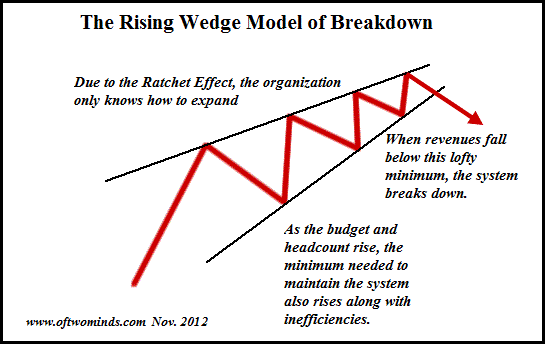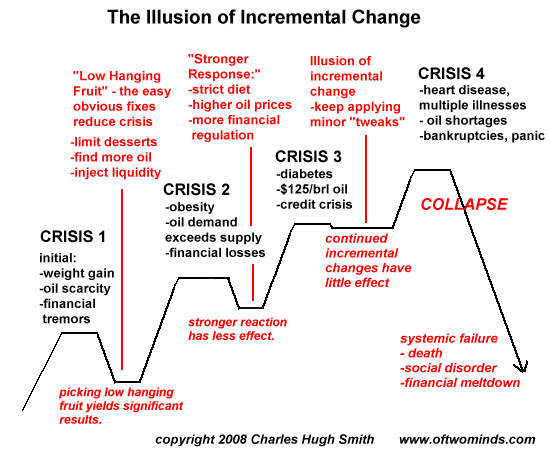Courtesy of Charles Hugh-Smith of OfTwoMinds blog,
We have created an economy with an extremely high cost-basis, and as a result it is brittle, fragile and vulnerable to cuts as modest as 4%.
In economies dependent on ever-rising consumption, austerity had a negative connotation even before its politically charged meaning commandeered the public debate. When the entire Status Quo depends on discretionary consumption not just for "growth" but for its survival, austerity is welcomed with approximately the same enthusiasm Superman reserves for Kryptonite.
This is of course a contradiction: an economy based not just on consumption of all net income but debt-based consumption is an economy devoid of savings, i.e. capital to invest in productive assets.
An economy without capital is lacking a key component of classic capitalism.
"Austerity" also suggests a preference for simplicity and productive work, another contradiction sociologist Daniel Bell explored in his 1988 book,
The Cultural Contradictions of Capitalism: the narcissistic consumption promoted by Neoliberal Capitalism erodes not just the work ethic that powers productive capitalism but also the ethic to save and invest that is the foundation (along with credit and transparent markets) of capitalism.
No wonder austerity is the equivalent of Kryptonite to the global consumption-dependent Status Quo. But there is another dynamic behind the panic and fear austerity has provoked, a dynamic I have characterized as The Rising Wedge Model of Breakdown, which builds on the well-known Ratchet Effect:
The Ratchet Effect is visible in organizations of all scales, from households to sprawling bureaucracies. The core of the Ratchet Effect is the ease with which the cost basis of an organization rises and the extreme resistance to any reduction in funding.
The psychology of this resistance is easy to understand: everyone hired in the expansion will fight to keep their job, regardless of the needs of the organization or the larger society. Every individual, department and division will fight with the fierceness of a cornered animal to retain their share of the budget, for their self-interest trumps the interests of the larger organization or society.
Since each "ratchet" will fight with desperate energy to resist being cut while those attempting to do the cutting are simply following directives, the group that has pulled out all the stops to resist cuts will typically win bureaucratic battles.
Broad-based cuts trigger Internecine Warfare Between Protected Fiefdoms as entrenched vested interests battle to shift the cuts to some politically less favored fiefdom. Bureaucracies facing cuts quickly shift resources to protecting their budget, leaving their mission on auto-control. (
The Lifecycle of Bureaucracy December 2, 2010)
These dynamics create a rising wedge in which "minimum" costs continue to rise over time even if modest cuts are imposed from time to time. The eventual consequence is a cost basis that is so high that even a modest reduction collapses the organization.
In other words, incremental reductions and reforms have become impossible. The organization has become so brittle that any structural reform triggers a breakdown.
We can use a household example to illustrate The Rising Wedge Model of Breakdown. Like many households, the Wedge Household responded to rising income and home equity in the bubble years by moving up to a larger home. Now the monthly payment on the Wedge McMansion is $4,000, as property taxes have soared. Healthcare costs have also skyrocketed, consuming over $1,000 a month of the family budget.
In response to declining real wages, the Wedge Household cut travel and dining out and cancelled cable/satellite TV channels. Unfortunately, these represent a relatively tiny percentage of the annual household budget, and the family's savings have been drained maintaining their high cost-basis lifestyle.
When the primary wage earner takes a 10% pay cut, the household's minimum cost basis is so high that the family has no choice but to cut one or another essential of middle class life: either the Wedges lose their health insurance or they default on their mortgage.
Their financial health has lost all resiliency; it is now fragile and brittle. (
Brittleness January 29, 2007)
This is a direct analogy for the nation's budget; a 10% reduction will trigger breakdown in the nation's brittle systems. Indeed, as I suggested in
Can 4% of Homeowners Sink the Entire Market? (February 21, 2007), even a 4% reduction could have an outsized impact on 64% of the economy. This is the Pareto Distribution in action: just as the vital 20% wields outsized influence over the 80%, the 20% of the 20% (4%) exerts outsized influence over 80% of the 80% (64%).
The loss of resilience and cost sensitivity has consequences. We have created an economy with an extremely high cost-basis, and as a result it is brittle, fragile and vulnerable to even modest "austerity."



